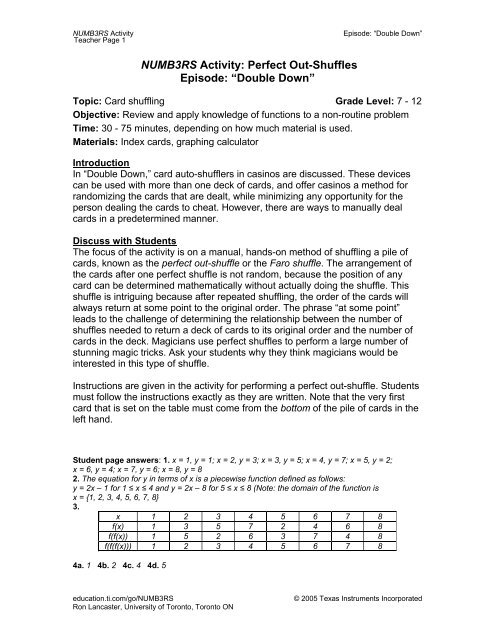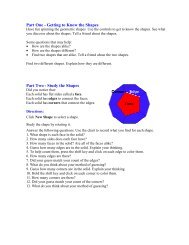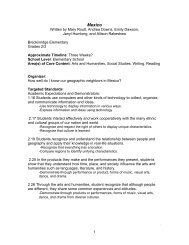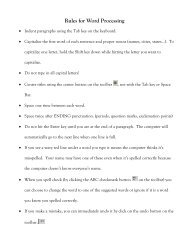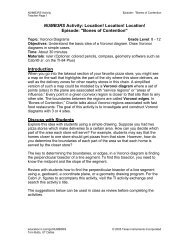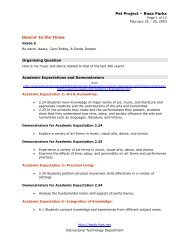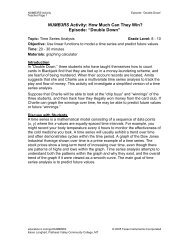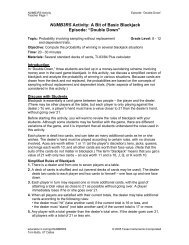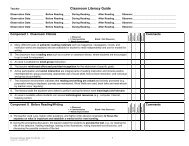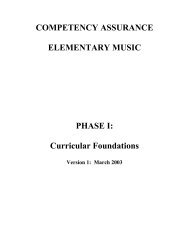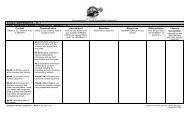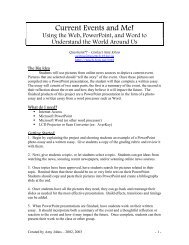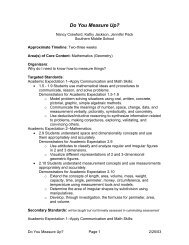Perfect Out Shuffles-Double Down Act 4
Perfect Out Shuffles-Double Down Act 4
Perfect Out Shuffles-Double Down Act 4
Create successful ePaper yourself
Turn your PDF publications into a flip-book with our unique Google optimized e-Paper software.
NUMB3RS <strong>Act</strong>ivityTeacher Page 1Episode: “<strong>Double</strong> <strong>Down</strong>”NUMB3RS <strong>Act</strong>ivity: <strong>Perfect</strong> <strong>Out</strong>-<strong>Shuffles</strong>Episode: “<strong>Double</strong> <strong>Down</strong>”Topic: Card shuffling Grade Level: 7 - 12Objective: Review and apply knowledge of functions to a non-routine problemTime: 30 - 75 minutes, depending on how much material is used.Materials: Index cards, graphing calculatorIntroductionIn “<strong>Double</strong> <strong>Down</strong>,” card auto-shufflers in casinos are discussed. These devicescan be used with more than one deck of cards, and offer casinos a method forrandomizing the cards that are dealt, while minimizing any opportunity for theperson dealing the cards to cheat. However, there are ways to manually dealcards in a predetermined manner.Discuss with StudentsThe focus of the activity is on a manual, hands-on method of shuffling a pile ofcards, known as the perfect out-shuffle or the Faro shuffle. The arrangement ofthe cards after one perfect shuffle is not random, because the position of anycard can be determined mathematically without actually doing the shuffle. Thisshuffle is intriguing because after repeated shuffling, the order of the cards willalways return at some point to the original order. The phrase “at some point”leads to the challenge of determining the relationship between the number ofshuffles needed to return a deck of cards to its original order and the number ofcards in the deck. Magicians use perfect shuffles to perform a large number ofstunning magic tricks. Ask your students why they think magicians would beinterested in this type of shuffle.Instructions are given in the activity for performing a perfect out-shuffle. Studentsmust follow the instructions exactly as they are written. Note that the very firstcard that is set on the table must come from the bottom of the pile of cards in theleft hand.Student page answers: 1. x = 1, y = 1; x = 2, y = 3; x = 3, y = 5; x = 4, y = 7; x = 5, y = 2;x = 6, y = 4; x = 7, y = 6; x = 8, y = 82. The equation for y in terms of x is a piecewise function defined as follows:y = 2x – 1 for 1 ≤ x ≤ 4 and y = 2x – 8 for 5 ≤ x ≤ 8 (Note: the domain of the function isx = {1, 2, 3, 4, 5, 6, 7, 8}3.x 1 2 3 4 5 6 7 8f(x) 1 3 5 7 2 4 6 8f(f(x)) 1 5 2 6 3 7 4 8f(f(f(x))) 1 2 3 4 5 6 7 84a. 1 4b. 2 4c. 4 4d. 5education.ti.com/go/NUMB3RSRon Lancaster, University of Toronto, Toronto ON© 2005 Texas Instruments Incorporated
NUMB3RS <strong>Act</strong>ivityStudent Page 1Name: __________________________________Episode: “<strong>Double</strong> <strong>Down</strong>”Date: ________________NUMB3RS <strong>Act</strong>ivity: <strong>Perfect</strong> <strong>Out</strong>-<strong>Shuffles</strong>In “<strong>Double</strong> <strong>Down</strong>,” card auto-shufflers in casinos are discussed. In this activity,you will analyze a different type of method for shuffling cards that is not randomin nature. This shuffle is used by magicians to mix a deck of cards in apredetermined way, and is commonly called a perfect out-shuffle or aFaro shuffle. To begin, try doing this shuffle with 8 cards.Step 1: Obtain 8 index cards and write the letters A, B, C, D, E, F, G, and H onthe cards as shown below (one letter per card).A B C D E F G HStep 2: Arrange the 8 cards in alphabetical order in a pile, with card A at the topand card H at the bottom. Pick up the 8 cards and hold them in your lefthand.Step 3: Take the top four cards in your right hand and leave the bottom fourcards in your left hand.Step 4: Place the bottom card of the pile in your left hand on the table. Thenplace the bottom card of the pile in your right hand on top of the card onthe table.Step 5: Repeat step 4 until all eight of the cards are in a pile on the table.If you have done the shuffle correctly, the order of the 8 cards from top to bottomis A, E, B, F, C, G, D, and H. Notice that the cards that were in the top andbottom positions (the outside cards) of the original stack of cards are still in thetop and bottom positions of the shuffled stack of cards. This is why this shuffle iscalled a perfect out-shuffle. (The word perfect is used because the cards arebeing moved in a predetermined manner instead of randomly.)If you do this shuffle two more times, the cards will be in the same order as theywere at the start! That is, after only three perfect out-shuffles, a deck of 8 cardswill return to its original order.education.ti.com/go/NUMB3RSRon Lancaster, University of Toronto, Toronto ON© 2005 Texas Instruments Incorporated
NUMB3RS <strong>Act</strong>ivityStudent Page 2Episode: “<strong>Double</strong> <strong>Down</strong>”1. Look at Table 1 below. The before column displays the order of the 8 cardsbefore being shuffled, and the after column shows the positions of the cardsafter one shuffle.Table 1 Table 2Before After x yA A 1B E 2C B 3 5D F 4E C 5F G 6G D 7H H 8Let x represent the position of a card before the shuffle and the y represent theposition afterwards. For example, note that the card in the third position (the C)ended up in the fifth position. This can be described by saying that if x = 3,then y = 5. Use the information in Table 1 to complete the missing entries inTable 2.2. Using Table 2, develop a formula that can be used to produce the value of yfor all values of x between 1 and 8. (Hint: You will need to use a piecewisefunction. Look at the y-values for 1 ≤ x ≤ 4 and 5 ≤ x ≤ 8.) How would yourformula change if a pile of 52 cards were used instead of 8?3. Let y = f(x), where f is the function that describes the relationship betweeny and x you found in Question #1. Find each of the following.x 1 2 3 4 5 6 7 8f(x)f(f(x))f(f(f(x)))4. At the start of this activity we saw that the order of a deck of 8 cards will berestored after 3 perfect out-shuffles. Using some index cards, make thefollowing decks. For each deck, manually perform as many perfect out-shufflesas needed to restore the cards to their original order. Search for a pattern andthen predict how many perfect shuffles would be needed for a deck of64 cards to its original order.(a) 2 cards (b) 4 cards (c) 16 cards (d) 32 cardseducation.ti.com/go/NUMB3RSRon Lancaster, University of Toronto, Toronto ON© 2005 Texas Instruments Incorporated
NUMB3RS <strong>Act</strong>ivityEpisode: “<strong>Double</strong> <strong>Down</strong>”The goal of this activity is to give your students a short and simple snapshot into a very extensivemath topic. TI and NCTM encourage you and your students to learn more about this topic using theextensions provided below and through your own independent research.ExtensionsFor the StudentIn this extension, you will have the opportunity to study the relationship between thenumber of cards in a deck n (where n is not a power of 2, as was the case inQuestion #4) and the number of shuffles S required to restore the deck to its originalorder.You will need to install the program SHUFFLE onto your TI-83/84 Plus calculator. Thisprogram can be downloaded for free at http://education.ti.com/exchange. Once theprogram has been loaded, run the program SHUFFLE. This program performs a perfectout-shuffle of n cards, and continues to shuffle the cards until the original order has beenrestored. The number of shuffles is displayed on the home screen at the end.Use the SHUFFLE program to complete the tables below.Numberof CardsNumber of<strong>Perfect</strong> <strong>Shuffles</strong>Numberof Cards2 324 346 368 3810 4012 4214 4416 4618 4820 5022 5224 5426 5628 5830 60Number of<strong>Perfect</strong> <strong>Shuffles</strong>Using your completed tables, look for a relationship between the number of cards in thedeck and the number of perfect shuffles required to restore the deck to its original order.How many perfect out-shuffles would be needed to restore decks of 62 or 66 cards totheir original orders? Use the SHUFFLE program to check your predictions.education.ti.com/go/NUMB3RSRon Lancaster, University of Toronto, Toronto ON© 2005 Texas Instruments Incorporated
NUMB3RS <strong>Act</strong>ivityEpisode: “<strong>Double</strong> <strong>Down</strong>”Shuffling and Magicians• When magicians perform a perfect out-shuffle, they do not perform it using themethod described in the activity. Skilled magicians are able to do the entire shufflewhile holding the cards in their hands, without using a table. Some magicians are ableto do this shuffle with one hand, a feat that leaves people stunned and in awe of theirskill. Details about how the deck is held and what the magician actually does can befound at http://web.superb.net/cardtric/sleights/outfaro.htm.• Another type of shuffle is called a perfect in-shuffle. To perform this shuffle, the firstcard you put on the table should be the bottom card from the pile of cards in your righthand. Using what you know about perfect out-shuffles, make a prediction about whatthe result of a perfect in-shuffle would be (think about the positions of the top andbottom cards of the original deck as well as the positions of the top card of each halfof the deck). Then check your prediction by using the 8 cards you created for theactivity to perform a perfect in-shuffle. What do you notice about the order of thecards? How might a magician use a perfect in-shuffle?• Magicians most typically use a standard deck of 52 cards. Why might a magician wantto perform a perfect out-shuffle? Think about how the magician could take advantageof the fact that the position of the top and bottom cards never change. Also, howmight a magician take advantage of the fact that the cards can be secretly restored totheir original positions?Additional ResourcesMagic Tricks, Card Shuffling and Dynamic Computer Memories, S. Brent MorrisISBN 0-88385-527-5, Mathematical Association of America, www.maa.orgThe Mathematics of Games, John D. Beasley, Oxford University Press,ISBN 0-19-286107-7Ivars Peterson’s Math Trek - Magic of <strong>Perfect</strong> <strong>Shuffles</strong> - August 1, 1998http://www.sciencenews.org/sn_arc98/8_1_98/mathland.htmShuffle: http://mathworld.wolfram.com/Shuffle.html - includes links to faro shuffle,perfect shuffle, and others.education.ti.com/go/NUMB3RSRon Lancaster, University of Toronto, Toronto ON© 2005 Texas Instruments Incorporated


